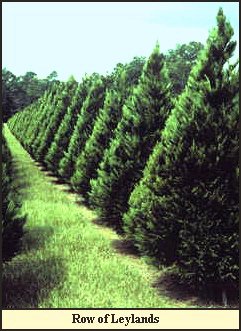
Leyland Cypress
x Cupressocyparis leylandii

This tree is a hybrid of Monterey cypress and Alaskan cedar. Six seedlings were
discovered in 1888 by C.J. Leyland at Leighton Hall in the South of Wales. The two parent trees were
growing on the Leighton Hall Estate and cross bred purely by accident. Mr. Leyland continued to
develop the trees with the assistance of his nephew J.M. Naylor during the early 1900's. In 1941,
rooted cuttings arrived in United States, through California, for the first time. In 1965, they found
their way to Clemson University in South Carolina where their use as Christmas trees became
apparent.
In England, the Leyland cypress is used as an ornamental and as a wind break. In
New Zealand and Australia, it is used for wood products. In the United States, it has become a valued
landscape plant and one of the most sought after Christmas trees.
This stately beauty is a sterile hybrid and must be propagated by individual cutting.
Leylands are aggressive plants. They secrete a natural herbicide from their roots to reduce the competition from surrounding vegetation. In its mature form, heights of 138' are expected, and the tree is
capable of withstanding temperatures of about 0 F.
The bark of the Leyland cypress is characterized by a skin-like texture. It is quite delicate. Care
should be exercised to ensure that it does not tear while being cut.
Today there are 8 cultivars of Leyland cypress.
- Haggerstown Grey
- Leighton Green*
- Gold Cup*
- Castlewellan*
- Green Spire
- Naylor's Blue
- Silverdust*
- Robinson's Gold
*Grown at Shady Pond Tree Farm
Leighton Green-

The Leighton Green has been the Leyland cypress cultivar most commonly
planted in Louisiana for use as Christmas trees. Interest in the Leighton Green variety has steadily
increased over the past few years and has resulted in Shady Pond Tree Farm planting more
of these beautiful trees. Limited inventories in the recent past has kept the price for Leylands
up. But beginning this year the price for the Leighton Green will be reduced significantly
because of the increased supply. They will be only slightly more expensive than Virginia Pines of the
same size.
The foliage of this tree is a dark forest green. It is heavy and stout with a somewhat
coarser appearance when compared to the other Leyland cultivars. It remains quite fresh when
properly cared for.
Castlewellan-

This Leyland variety has very delicate lacy foliage. In winter, the exterior of the tree
turns gold while the interior remains green. Castlewellans are noted for their strong tendency to conical
growth. Castlewellans are still in limited supply and as such will be somewhat higher priced.
Silver Dust-

These Leylands are identified by the white variegated splotches on the foliage. Their leaf
structure is otherwise very similar to that of Leighton Green. As with Castlewellan, Silver Dust
is in limited supply.





